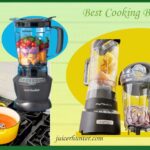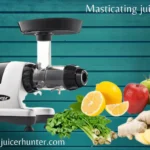The newest trend that is taking over the fitness industry is juicing. Consumers today have a perplexing array of juicing choices, including centrifugal juicers, cold press juicers, masticating juicers, fast juicers, slow juicers, and even a variety of juicers. The choices may feel overwhelming if you’re attempting to start juicing and are health-conscious.
To assist you in choosing the best Juicer and the difference between a high-speed and low-speed juicer, technical research is conducted on your behalf, and compile a short guide on the various types of juicers.
Slow Juicer Vs Fast Juicer — Which One Is Best?
Fast Juicers / centrifugal juicers
A fast juicer is the most common form of the best Juicer for celery available today. The fast juicer functions by dissolving fruits, veggies, and some plants into a significant amount of juice for your pleasure using a rapidly spinning centrifugal mesh. For quick and straightforward cleanup, the pulp from the liquid is immediately poured into a different receptacle.
Advantages
Centrifugal juicers are popular due to their quick juicing speed, capacity to create large amounts of juice by dissolving most of the cellular in the vegetables and fruits you juice, simplicity of washing, reduced price, and absence of pulp for those who dislike pulp. You can easily and quickly consume all of the FDA-recommended daily servings of fruit and veggies by swiftly and effectively juicing a vast group of fruits and vegetables.
Overall, the quick Juicer is ideal for a person constantly on the go with little time to waste on a sluggish juicer; it is also ideal for anyone wanting to start juicing due to its cheap cost and ease of cleaning.
Drawbacks
Even though fast juicers are excellent, they have disadvantages compared to sluggish juicers. A loss of decibels accompanies the pace of the fast juicers; when in use, the fast juicers are slightly noisier than the slow juicers. Due to the mesh blade’s rapid whirling, the quick juicers also generate a little bit more heat. Due to the heat produced, the juice will become foamier and more likely to split; this problem can be fixed by stirring the juice and letting it re-group.
The value of nutrient content users retrieve from a high-speed juicer and the value of the juice alone are two cons that are hotly contested. Some users claim that fast juicers produce juice and nutrients of lower quality, but this has not been scientifically proven, so take their claims with a pinch of salt.
Slow Juicers / Cold Press Juicers
When it comes to juicers, slow juicers are the newest adolescents on the block. Due to their higher price, longer juice times, and marginally lesser juice output, fast and cold press juicers are less common than fast juicers. Slow juicers produce juice by pulverizing the fruit and veggies. Due to their slower operation, slow juicers do not generate as much heat as fast juicers, but they create more pulp, resulting in slightly more nutrients in the juice.
For those who enjoy pulpy juice with little to no foam, cleaning the juicer results in slightly more vitamins and a slightly higher quality of juice with plenty of pulp. Slow juicers typically have more components than fast juicers, making them harder to clean. The cold press juicer’s processing of leafy vegetables, sprouts, kale, plants, and cereals is where it shines.
Slow juicers are ideal for those who are meticulous about getting the most nutrition out of the juice and are okay with taking their time preparing and cleaning the juice. Some novices may choose not to use a slow juicer due to the higher starting expense.
Advantages
Slow juicers have several benefits over quick juicers. The ability of a slow juicer to process leafy plants like peppermint, cabbage, seedlings, barley hay, and other herbs is by far its most significant benefit. The green leaves, fruits, and veggies fed into the machine are slowly crushed to obtain the most outstanding nutrients. Some contend that the pulp and added nutrients of the cold press juicers produce juice of a better calibre. Compared to its fast-juicing cousin, the slow juicer is much calmer.
Drawbacks
Because slow juicers lack a pulp dumping device, extra pulp that doesn’t end up in the juice receptacle gets trapped inside the machine, making cleanup more challenging. It certainly requires more patience to wait for your juice and sanitize the equipment after you are finished juicing, making the slow Juicer inefficient for people constantly on the go. The initial expense is the most significant hurdle to the entrance; some sluggish juicers can cost up to two or three times as much as a fast juicer.
Best Centrifugal Juicers
Investing in the finest centrifugal Juicer is unquestionably worthwhile. One of the fastest and simplest methods to increase your consumption of fruits and vegetables is to do so. Creating your own fresh, nutritious drinks at home not only costs less than choices from the store but also gives you complete control over the ingredients.
Among the scoring juicers are:
- Breville Juice Fountain Elite 800JEXL
- Power XL Juicer
- Dash Compact Centrifuge Juicer
Best Cold Press Juicers
With the finest cold press juicers, consuming a variety of plant-based nutrition without any additional sugars is simple and can be done at home. And that’s a good thing because fresh juice tastes excellent and is an effective, simple method to consume your daily servings of fruits and vegetables. Among the rating, omega juicers are the best choice. Some juicers are:
- Omega MM 900HDS
- Omega J 8006 HDS
- Omega 900 HDC
Verdict
Both Slow Juicers and Rapid Juicers have benefits and drawbacks. The fast Juicer is ideal for those new to juicing and who desire a low entrance hurdle into the delightful world of juicing. Compared to sluggish juicers, the quick Juicer is more affordable, effective, straightforward to clean, and has fewer drawbacks. The slow juicers are ideal for people who are seriously interested in juicing verdant vegetables, want the juice to be as nutrient-dense as possible, and are okay with paying more for it and needing to maintain it more frequently.






